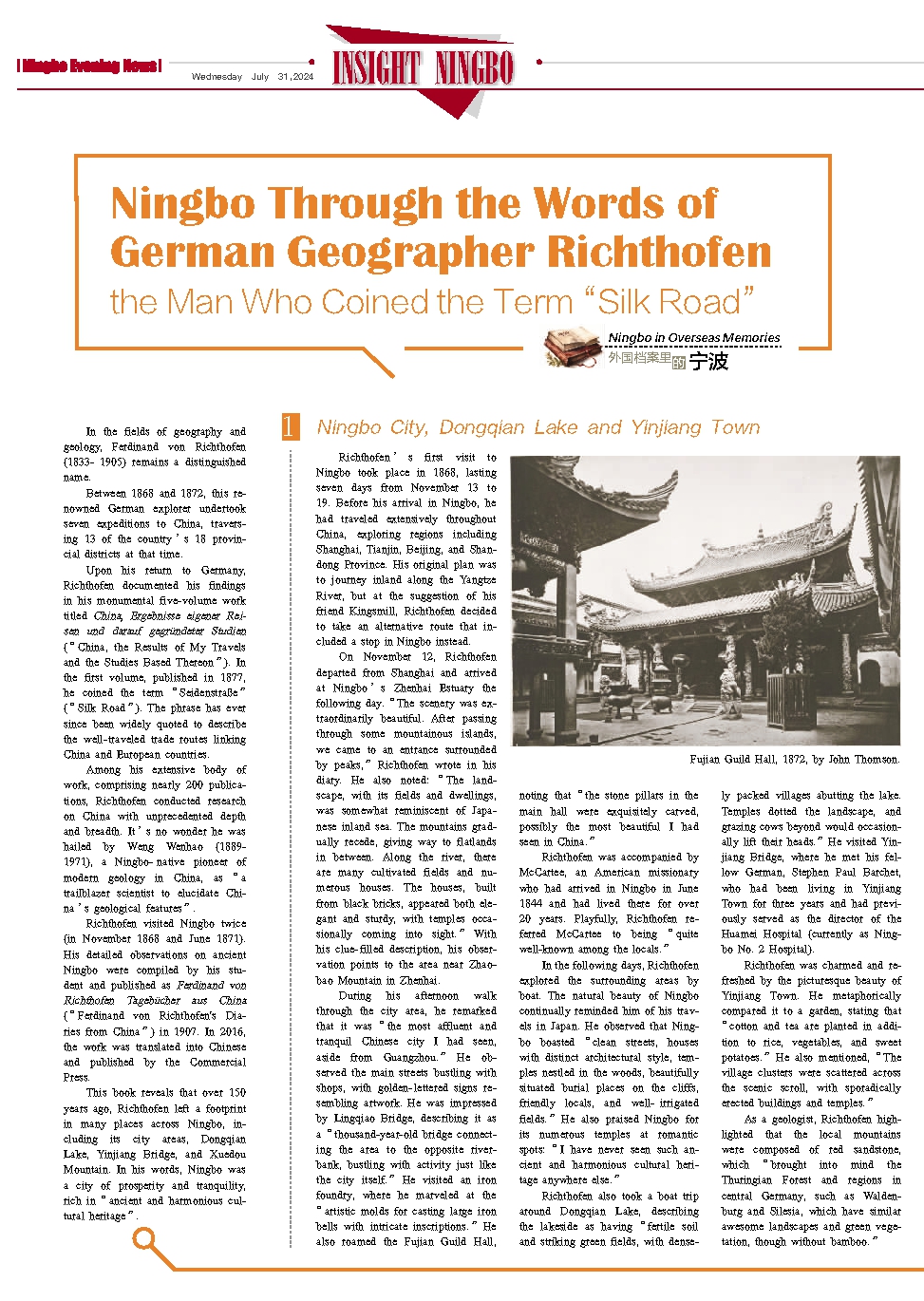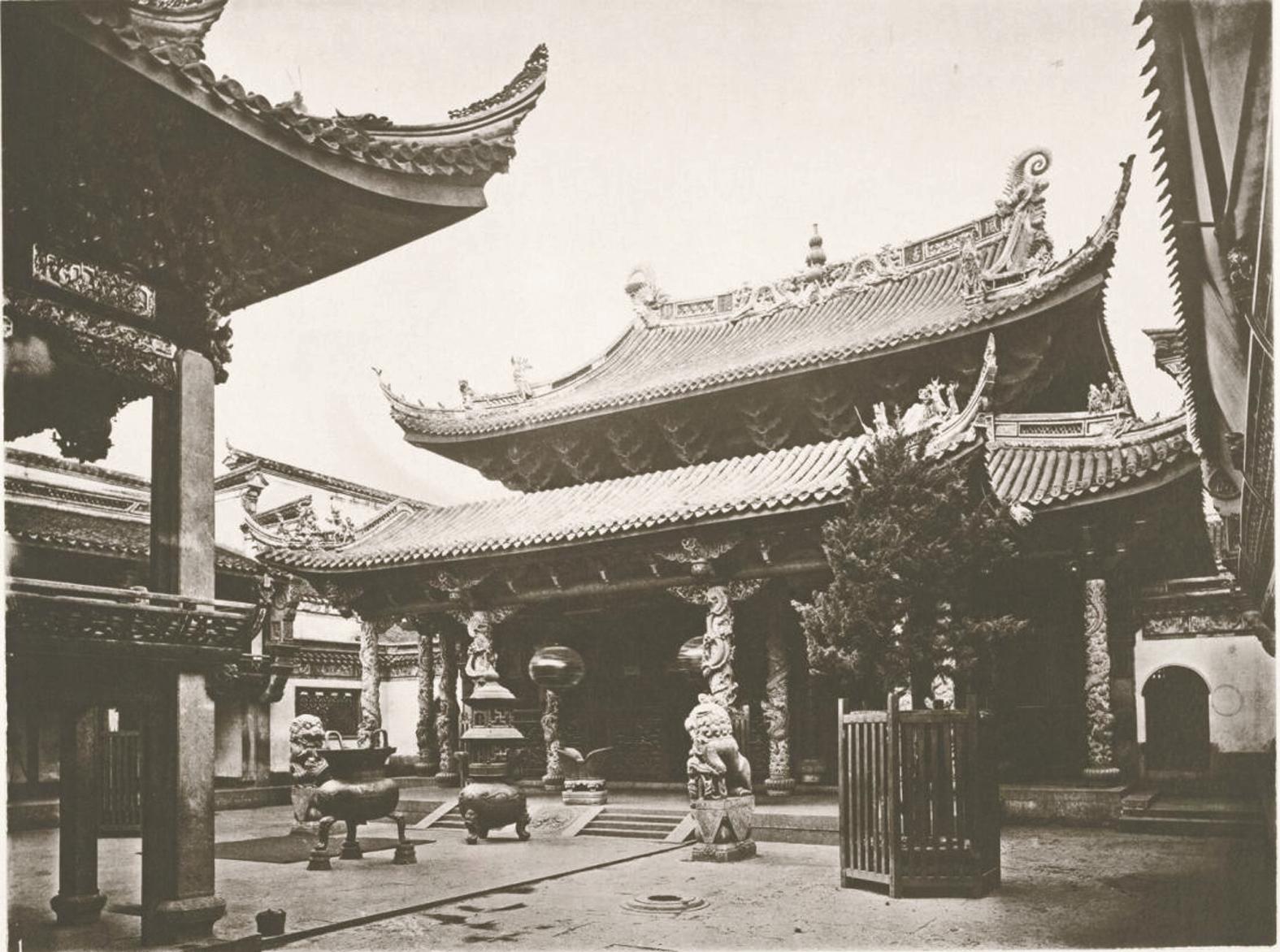In the fields of geography and geology, Ferdinand von Richthofen (1833- 1905) remains a distinguished name.
Between 1868 and 1872, this renowned German explorer undertook seven expeditions to China, traversing 13 of the country’s 18 provincial districts at that time.
Upon his return to Germany, Richthofen documented his findings in his monumental five-volume work titled China, Ergebnisse eigener Reisen und darauf gegründeter Studien (“China, the Results of My Travels and the Studies Based Thereon”). In the first volume, published in 1877, he coined the term “Seidenstraße” (“Silk Road”). The phrase has ever since been widely quoted to describe the well-traveled trade routes linking China and European countries.
Among his extensive body of work, comprising nearly 200 publications, Richthofen conducted research on China with unprecedented depth and breadth. It’s no wonder he was hailed by Weng Wenhao (1889-1971), a Ningbo-native pioneer of modern geology in China, as “a trailblazer scientist to elucidate China’s geological features”.
Richthofen visited Ningbo twice (in November 1868 and June 1871). His detailed observations on ancient Ningbo were compiled by his student and published as Ferdinand von Richthofen Tagebücher aus China (“Ferdinand von Richthofen's Diaries from China”) in 1907. In 2016, the work was translated into Chinese and published by the Commercial Press.
This book reveals that over 150 years ago, Richthofen left a footprint in many places across Ningbo, including its city areas, Dongqian Lake, Yinjiang Bridge, and Xuedou Mountain. In his words, Ningbo was a city of prosperity and tranquility, rich in “ancient and harmonious cultural heritage”.
1
Ningbo City, Dongqian Lake and Yinjiang Town
Richthofen’s first visit to Ningbo took place in 1868, lasting seven days from November 13 to 19. Before his arrival in Ningbo, he had traveled extensively throughout China, exploring regions including Shanghai, Tianjin, Beijing, and Shandong Province. His original plan was to journey inland along the Yangtze River, but at the suggestion of his friend Kingsmill, Richthofen decided to take an alternative route that included a stop in Ningbo instead.
On November 12, Richthofen departed from Shanghai and arrived at Ningbo’s Zhenhai Estuary the following day. “The scenery was extraordinarily beautiful. After passing through some mountainous islands, we came to an entrance surrounded by peaks,” Richthofen wrote in his diary. He also noted: “The landscape, with its fields and dwellings, was somewhat reminiscent of Japanese inland sea. The mountains gradually recede, giving way to flatlands in between. Along the river, there are many cultivated fields and numerous houses. The houses, built from black bricks, appeared both elegant and sturdy, with temples occasionally coming into sight.” With his clue-filled description, his observation points to the area near Zhaobao Mountain in Zhenhai.
During his afternoon walk through the city area, he remarked that it was “the most affluent and tranquil Chinese city I had seen, aside from Guangzhou.” He observed the main streets bustling with shops, with golden-lettered signs resembling artwork. He was impressed by Lingqiao Bridge, describing it as a “thousand-year-old bridge connecting the area to the opposite riverbank, bustling with activity just like the city itself.” He visited an iron foundry, where he marveled at the “artistic molds for casting large iron bells with intricate inscriptions.” He also roamed the Fujian Guild Hall, noting that “the stone pillars in the main hall were exquisitely carved, possibly the most beautiful I had seen in China.”
Richthofen was accompanied by McCartee, an American missionary who had arrived in Ningbo in June 1844 and had lived there for over 20 years. Playfully, Richthofen referred McCartee to being “quite well-known among the locals.”
In the following days, Richthofen explored the surrounding areas by boat. The natural beauty of Ningbo continually reminded him of his travels in Japan. He observed that Ningbo boasted “clean streets, houses with distinct architectural style, temples nestled in the woods, beautifully situated burial places on the cliffs, friendly locals, and well-irrigated fields.” He also praised Ningbo for its numerous temples at romantic spots: “I have never seen such ancient and harmonious cultural heritage anywhere else.”
Richthofen also took a boat trip around Dongqian Lake, describing the lakeside as having “fertile soil and striking green fields, with densely packed villages abutting the lake. Temples dotted the landscape, and grazing cows beyond would occasionally lift their heads.” He visited Yinjiang Bridge, where he met his fellow German, Stephen Paul Barchet, who had been living in Yinjiang Town for three years and had previously served as the director of the Huamei Hospital (currently as Ningbo No. 2 Hospital).
Richthofen was charmed and refreshed by the picturesque beauty of Yinjiang Town. He metaphorically compared it to a garden, stating that “cotton and tea are planted in addition to rice, vegetables, and sweet potatoes.” He also mentioned, “The village clusters were scattered across the scenic scroll, with sporadically erected buildings and temples.”
As a geologist, Richthofen highlighted that the local mountains were composed of red sandstone, which “brought into mind the Thuringian Forest and regions in central Germany, such as Waldenburg and Silesia, which have similar awesome landscapes and green vegetation, though without bamboo.”



